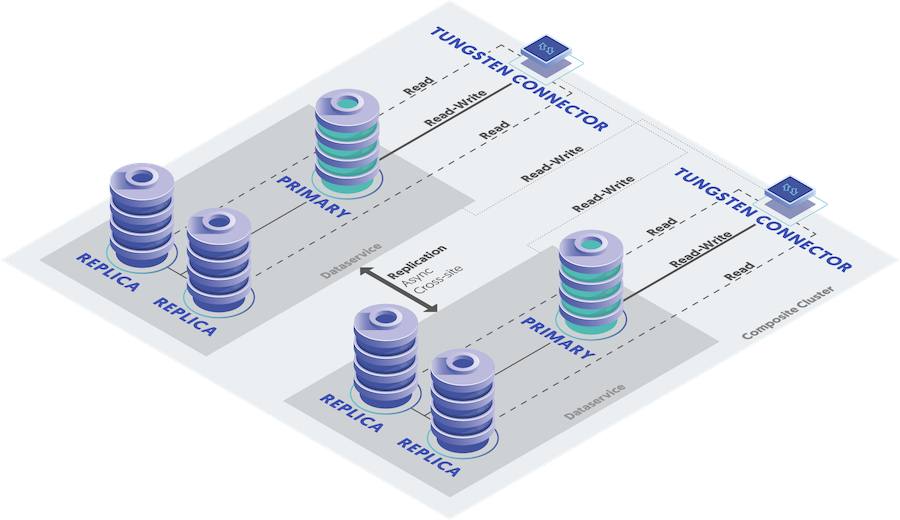- 3.3.1. Prepare: Composite Active/Active Clusters
- 3.3.2. Install: Composite Active/Active Clusters
- 3.3.3. Best Practices: Composite Active/Active Clusters
- 3.3.4. Resetting a single dataservice
- 3.3.5. Resetting all dataservices
- 3.3.6. Dataserver maintenance
- 3.3.7. Adding a Cluster to a Composite Active/Active Topology
A Composite Active/Active (CAA) Cluster topology provides all the benefits of a typical dataservice at a single location, but with the benefit of also replicating the information to another site. The underlying configuration within Tungsten Cluster uses two services within each node; one provides the replication within the cluster, and the second provides replication from the remote cluster. Both are managed by the Tungsten Manager
Note
Composite Active/Active Clusters were previously referred to as Multi-Site/Active-Active (MSAA) clusters. The name has been updated to reflect the nature of these clusters as part of an overall active/active deployment using clusters, where the individual clusters could be in the same or different locations.
Whilst the older Multi-Site/Active-Active topology is still valid and supported, it is recommended that this newer Composite Active/Active topology is adopted from version 6 of Tungsten Cluster onwards. For details on the older topology, see Section 3.5, “Deploying Multi-Site/Active-Active Clustering”
The configuration is handled with a single configuration and deployment that configures the core cluster services and additional cross-cluster services.
A sample display of how this operates is provided in Figure 3.3, “Topologies: Composite Active/Active Clusters”.
The service can be described as follows:
Tungsten Cluster Service:
eastReplicates data between
east1,east2andeast3.Tungsten Cluster Service:
westReplicates data between
west1,west2andwest3.Tungsten Cluster Service:
west_from_eastDefines the replication service using a secondary sub-service within the cluster. This service reads THL FROM
eastand writes to therelaynode inwest, subsequently, thereplicanodes withinwestare then replicated to from there.Tungsten Replicator Service:
east_from_westDefines the replication service using a secondary sub-service within the cluster. This service reads THL FROM
westand writes to therelaynode ineast, subsequently, thereplicanodes withineastare then replicated to from there.
A new Composite Dynamic Active/Active topology was introduced from version 7.0.0 of Tungsten Cluster
Composite Dynamic Active/Active builds on the foundation of the Composite Active/Active topology and the cluster continues to operate and be configured in the same way.
The difference is, with Composite Dynamic Active/Active, the cluster instructs the Proxy layer to behave like a Composite Active/Passive cluster.
For more information on this topology and how to enable it, see Section 3.4, “Deploying Composite Dynamic Active/Active”
